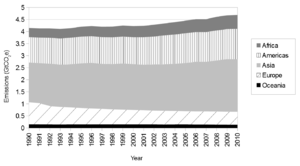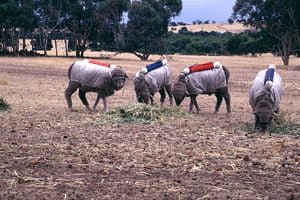
The agricultural sector is a driving force in the gas emissions and land use effects thought to cause climate change. In addition to being a significant user of land and consumer of fossil fuel, agriculture contributes directly to greenhouse gas emissions through practices such as rice production and the raising of livestock;[1] according to the Intergovernmental Panel on Climate Change, the three main causes of the increase in greenhouse gases observed over the past 250 years have been fossil fuels, land use, and agriculture.[2]
Land use[edit | edit source]
Agriculture contributes to greenhouse gas increases through land use in four main ways:
- CO2 releases linked to deforestation
- Methane releases from rice cultivation
- Methane releases from enteric fermentation in cattle
- Nitrous oxide releases from fertilizer application
Together, these agricultural processes comprise 54% of methane emissions, roughly 80% of nitrous oxide emissions, and virtually all carbon dioxide emissions tied to land use.[3]
The planet's major changes to land cover since 1750 have resulted from deforestation in temperate regions: when forests and woodlands are cleared to make room for fields and pastures, the albedo of the affected area increases, which can result in either warming or cooling effects, depending on local conditions.[4] Deforestation also affects regional carbon reuptake, which can result in increased concentrations of CO2, the dominant greenhouse gas.[5] Land-clearing methods such as slash and burn compound these effects by burning biomatter, which directly releases greenhouse gases and particulate matter such as soot into the air.
Livestock[edit | edit source]
Livestock and livestock-related activities such as deforestation and increasingly fuel-intensive farming practices are responsible for over 18%[6] of human-made greenhouse gas emissions, including:
- 9% of global carbon dioxide emissions
- 35–40% of global methane emissions (chiefly due to enteric fermentation and manure)
- 64% of global nitrous oxide emissions (chiefly due to fertilizer use.[7])
Livestock activities also contribute disproportionately to land-use effects, since crops such as corn and alfalfa are cultivated in order to feed the animals.
In 2010, enteric fermentation accounted for 43% of the total greenhouse gas emissions from all agricultural activity in the world.[8] The meat from ruminants has a higher carbon equivalent footprint than other meats or vegetarian sources of protein based on a global meta-analysis of lifecycle assessment studies.[9] Methane production by animals, principally ruminants, is estimated 15-20% global production of methane.[10][11]
Worldwide, livestock production occupies 70% of all land used for agriculture, or 30% of the land surface of the Earth.[12]
Greenhouse gas emissions[edit | edit source]

At a global scale, the FAO has recently estimated that livestock (including poultry) accounts for about 14.5 percent of anthropogenic greenhouse gas emissions estimated as 100-year CO2 equivalents.[13] A previous, widely cited FAO report using somewhat more comprehensive analysis had estimated 18 percent. Because this emission percentage includes contributions associated with livestock used for production of draft power, eggs, wool and dairy products, the percentage attributable to meat production alone is significantly lower, as indicated by the report's data. The indirect effects contributing to the percentage include emissions associated with production of feed consumed by livestock and carbon dioxide emission from deforestation in Central and South America, attributed to livestock production. Using a different sectoral assignment of emissions, the IPCC (Intergovernmental Panel on Climate Change) has estimated that agriculture (including not only livestock, but also food crop, biofuel and other production) accounted for about 10 to 12 percent of global anthropogenic greenhouse gas emissions (expressed as 100-year carbon dioxide equivalents) in 2005[14] and in 2010.[15]
In the US, methane emissions associated with ruminant livestock (6.4 Mt in 2013)[16] are estimated to have declined by about 17 percent from 1980 through 2012. Globally, enteric fermentation (mostly in ruminant livestock) accounts for about 27 percent of anthropogenic methane emissions,[17] and methane accounts for about 32 to 40 percent of agriculture's greenhouse gas emissions (estimated as 100-year carbon dioxide equivalents) as tabulated by the IPCC.[15]Methane has a global warming potential recently estimated as 35 times that of an equivalent mass of carbon dioxide.[17]However, despite the magnitude of methane emissions (recently about 330 to 350 Tg per year from all anthropogenic sources), methane's current effect on global warming is quite small. This is because degradation of methane nearly keeps pace with emissions, resulting in relatively little increase in atmospheric methane content (average of 6 Tg per year from 2000 through 2009), whereas atmospheric carbon dioxide content has been increasing greatly (average of nearly 15,000 Tg per year from 2000 through 2009).[17]
Mitigation options for reducing methane emission from ruminant enteric fermentation include genetic selection, immunization, rumen defaunation, diet modification and grazing management, among others.[18][19][20] The principal mitigation strategies identified for reduction of agricultural nitrous oxide emission are avoiding over-application of nitrogen fertilizers and adopting suitable manure management practices.[21][22] Mitigation strategies for reducing carbon dioxide emissions in the livestock sector include adopting more efficient production practices to reduce agricultural pressure for deforestation (notably in Latin America), reducing fossil fuel consumption, and increasing carbon sequestration in soils.[13]
In New Zealand, nearly half of [anthropogenic] greenhouse gas emission is associated with agriculture, which plays a major role in the nation's economy, and a large fraction of this is assignable to the livestock industry.[23] Some fraction of this is assignable to meat production: FAO data indicate that meat accounted for about 7 percent of product tonnage from New Zealand's livestock (including poultry) in 2010.[8] Livestock sources (including enteric fermentation and manure) account for about 3.1 percent of US anthropogenic greenhouse gas emissions expressed as carbon dioxide equivalents, according to US EPA figures compiled using UNFCCC methodologies.[24] Not all forms of meat and animal–based foods affect the environment equally. One study estimates that red meats are 150% more greenhouse gas intensive than chicken or fish.[25] According to another research group, the ranking of some food products in relation to greenhouse gas emissions is lamb (#1), beef (#2), cheese (#3), and pork (#4).[26] However, such ranking may not be broadly representative. Among sheep production systems, for example, there are very large differences in both energy use[27] and prolificacy;[28] both factors strongly influence emissions per kg of lamb production.
References[edit | edit source]
- ↑ Food and Agriculture Organization of the UN retrieved 25 June 2007
- ↑ (IPCC)
- ↑ Intergovernmental Panel on Climate Change Special Report on Emissions Scenarios retrieved 26 June 2007
- ↑ "Intergovernmental Panel on Climate Change".
- ↑ IPCC Technical Summary retrieved 25 June 2007
- ↑ Steinfeld, Henning; Gerber, Pierre; Wassenaar, T. D.; Castel, Vincent; Haan, Cees de (1 January 2006). "Livestock's Long Shadow: Environmental Issues and Options". Food & Agriculture Org..
- ↑ [Food and Agricultural Organization of the U.N.] retrieved 25 June 2007
- ↑ 8.0 8.1 Food and Agriculture Organization of the United Nations (2013) "FAO STATISTICAL YEARBOOK 2013 World Food and Agriculture". See data in Table 49.
- ↑ Ripple, William J.; Pete Smith; Helmut Haberl; Stephen A. Montzka; Clive McAlpine & Douglas H. Boucher. 2014. "Ruminants, climate change and climate policy". Nature Climate Change. Volume 4 No. 1. P 2-5.
- ↑ Cicerone, R. J., and R. S. Oremland. 1988 "Biogeochemical Aspects of Atmospheric Methane"
- ↑ Yavitt, J. B. 1992. Methane, biogeochemical cycle. Pages 197–207 in Encyclopedia of Earth System Science, Vol. 3. Acad.Press, London, England.
- ↑ Food and Agricultural Organization of the U.N. retrieved 27 June 2007
- ↑ 13.0 13.1 Gerber, P. J., H. Steinfeld, B. Henderson, A. Mottet, C. Opio, J. Dijkman, A. Falcucci and G. Tempio. 2013. Tackling climate change through livestock - a global assessmaent of emissions and mitigation opportunities. Food and Agriculture Organization of the United Nations, Rome. 115 pp.
- ↑ Intergovernmental Panel on Climate Change. 2007. Climate change 2007, Mitigation of climate change. Fourth Assessment Report
- ↑ 15.0 15.1 Intergovernmental Panel on Climate Change. 2014. Climate change 2014, Mitigation of climate change. Fifth Assessment Report.
- ↑ US Environmental Protection Agency. 2015. Inventory of U.S. greenhouse gas emissions and sinks, 1990-2013. EPA 430-R-15-004.
- ↑ 17.0 17.1 17.2 Intergovernmental Panel on Climate Change. 2013. Climate change 2013, The physical science basis. Fifth Assessment Report.
- ↑ Boadi, D. 2004. Mitigation strategies to reduce enteric methane emissions from dairy cows: Update review. Can. J. Anim. Sci. 84:319–335 DOI 10.4141/a03-109
- ↑ Martin, C. et al. 2010. Methane mitigation in ruminants: from microbe to the farm scale. Animal 4: pp 351-365.
- ↑ Eckard, R. J. (2010). "Options for the abatement of methane and nitrous oxide from ruminant production: A review". Livestock Science 130: 47–56. doi:10.1016/j.livsci.2010.02.010.
- ↑ Dalal, R.C. (2003). "Nitrous oxide emission from Australian agricultural lands and mitigation options: a review". Australian Journal of Soil Research 41 (2): 165–195. doi:10.1071/sr02064.
- ↑ Klein, C. A. M.; Ledgard, S. F. (2005). "Nitrous oxide emissions from New Zealand agriculture – key sources and mitigation strategies". Nutrient Cycling in Agroecosystems 72: 77–85. doi:10.1007/s10705-004-7357-z.
- ↑ Voluntary Greenhouse Gas Reporting Feasibility Study. 2. Agricultural sector GHG emissions in NZ. http://maxa.maf.govt.nz/climatechange/slm/vggr/page-01.htm
- ↑ US EPA. 2009. Inventory of U.S. greenhouse gas emissions and sinks: 1990-2007. United States Environmental Protection Agency. 410 pp.
- ↑ Weber, C. L.; Matthews, H. S. (2008). "Food-miles and the relative climate impacts of food choices in the United States". Environ Sci Technol 42 (10): 3508–3513. doi:10.1021/es702969f.
- ↑ "The Impacts - 2011 Meat Eater's Guide to Climate Change + Health". Environmental Working Group. 2011.
- ↑ Gee, K. 1980. Cultural energy in sheep production. In: Handbook of Energy Utilization in Agriculture. CRC Press, Boca Raton. pp. 425-430
- ↑ USDA. 2010. Agricultural Statistics 2010, Table 7-43.
This page contains content from: